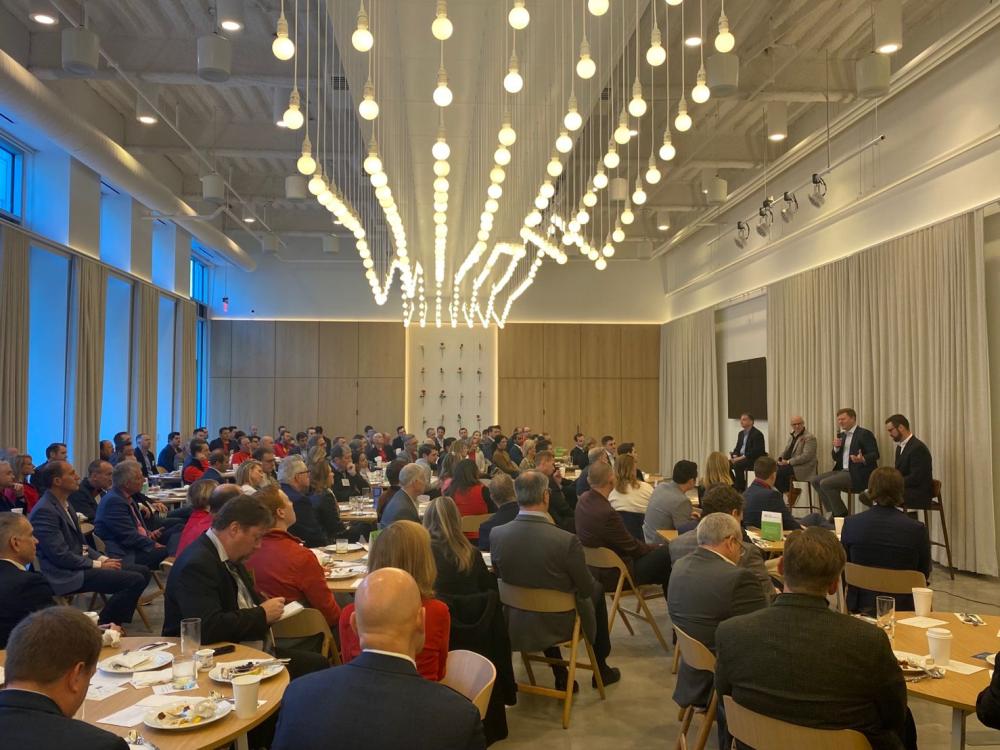
February 10, 2023

M&A deals and available capital are likely to continue slowing down this year, though some companies still see growth on the horizon for 2023. Creative approaches are called for to keep the pipeline open and get deals done.
This consensus emerged at ACG’s monthly meeting Feb. 10. The presentation theme was “Trends in Middle Market M&A and Capital Availability.”
The panel comprised:
- Chris Atkins, who leads a lending business for C2FO
- Tim Hannan, chief financial officer of The BERKS Group
- Sean Kelley, managing director of Gridiron Capital
- Moderator: Bill Conway, managing director of CC Capital Advisors
Conway started the program by asking the panelists to characterize the current M&A market and give a forecast for 2023.
Gridiron Capital typically makes controlled investments in companies that generate at least $100 million in revenue, Kelley said. The market has shifted from a recurring deal flow of about 1,000 opportunities a year “to more matchmaking.”
“We’re a thematic investor, so when we meet with business investors, we’re meeting them with a purpose,” he said. “We have to understand their markets and how we can help them, so that’s where we talk a lot about partnership. I would suspect continued depressed deal flow, getting done but curated differently.”
Hannan said deals would continue to slow until late this year or early next. The quality of opportunities in 2022 was “not very strong” because rising interest rates made doing deals more difficult. For The BERKS Group, “it’s about being patient to find things that work for us.”
“We want to acquire new customers,” Hannan said. “Most important is, do they add something different, new capabilities, new talent we can retain?”
Atkins said controlled sales had “slowed down broadly, but we’re seeing a ton of growth in our funds, with companies rearranging and some seeing fantastic growth.” Prime rated doubled in the United States throughout 2022. C2FO “saw a dramatic slowdown, especially on the debt side.” Basic bank rates moved from 4% to 8% or 9% and SBA rates exceeded 10%. He called these changes “shocking to our system.”
“I think we’ll see margins slim and inflation continue to rise,” Atkins said.
Conway asked the panel how they had changed their deal structures given the current climate. Kelley said Gridiron is “over-equitizing investments” and not financing deals with expensive debt.
“We’ve heard of a number of even billion-dollar enterprise-value deals with seller financing,” Kelley said. “You have a founder who’s created a business of enormous size, and they’re going to get massive proceeds back. So not only are they rolling over equity but they’re also providing the debt backstop as a seller-financing tool. It goes back to: Is this a company you want to own, and if it is, what are the means to do so?”
Conway asked whether valuations were still “frothy” in light of more creative seller financing. Hannan said that “at the top end for really good customers or opportunities, then I would say yes.” For companies without growth history, valuation is softening amid interest rate and recessions risks.
Atkins said that from the technology perspective, “it’s been gutted largely due to tech growth and pricing pressure.”
“As inflation spools up, it just flows through the prices,” he said. “The basic answer is more expensive debt crushes the value.”
Tech will revive, though, Atkins said. He called seller financing a “perfect illustration of the inverted yield curve.” A seller that can make 12% on the note, for example, is likely to do it. When the yield falls, the seller trades out of it.
“For us, it’s the private markets,” Kelley said. The company doesn’t have the luxury of trading out of a stock on a given day. For it to buy a company takes months or even years. Selling one takes the same amount of time “and you have to have buyers willing to show up.”
“Patience is a virtue, but you also have to be growth minded,” he said. “I would argue that our companies are always for sale but for sale at the right price.”
Conway asked the panel what’s required to get a premium valuation in today’s market. Hannan said growth through the ability to increase the customer base to have pricing power, scalability of processes and systems, and talent level and retention, all translating to “the ability to step into an opportunity and not have to fix it but just put your foot on the accelerator.”
Kelley emphasized the importance of having the right talent and asking whether you’re the right investor to back the management team in question. Also, analyzing the numbers to determine what’s real versus what’s documented.
“Where projects are too bogus, it’s a good excuse to walk away,” Kelley said.
Atkins described the current level of competition by saying “there’s still tons and tons of money.” Control and growth equity on new investments is slowing. A lot of credit remains “but many are puckering.”
“We’re still in the absolute best period in human history,” Atkins said. “There’s immense wealth out there. Much of it is transferrable, and much of it is available at the right price.”
Conway asked the panelists what kept them up at night.
“Supply chain,” Atkins said, which Kelley echoed. “Pipeline,” Hannan said.
And what’s the word for 2023?
“Settle down,” Atkins said. “Hyper-selective,” Kelley answered. “Patience,” Hannan said.

Register by January 14 to maximize value, elevate your experience, and get a head start connecting with 3,200+ dealmakers and executives.
